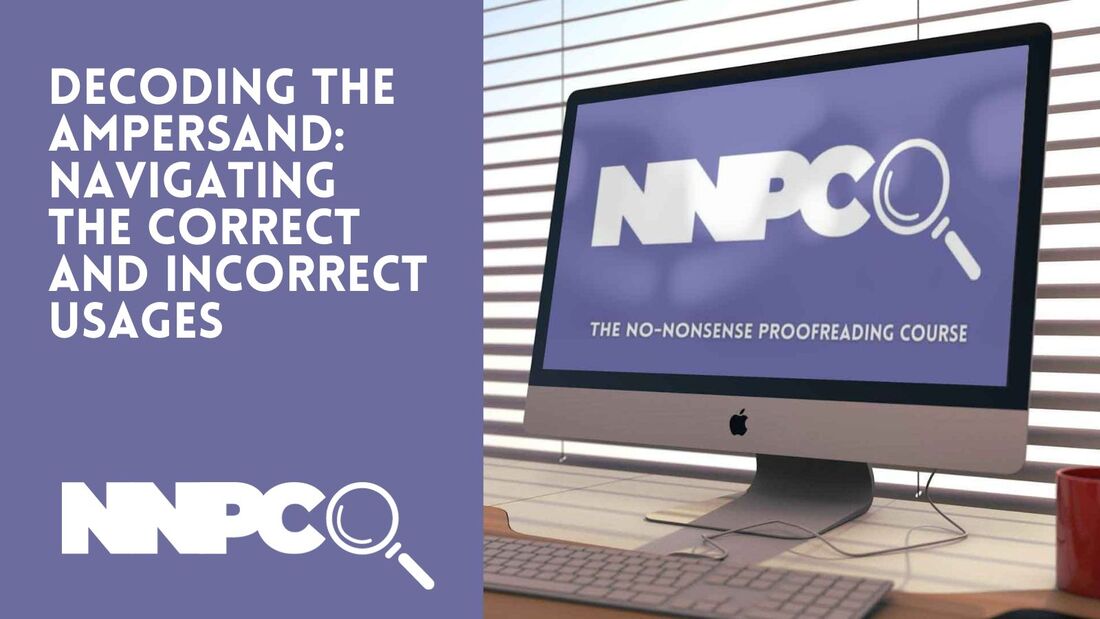|
In the vast realm of punctuation, the ampersand (&) stands out as a unique and often misunderstood character. Originating from the Latin word "et," meaning "and," the ampersand has a rich history and a distinct role in language. However, its usage can be a source of confusion. Today, we'll delve into the correct and incorrect usages of the ampersand, shedding light on how to wield this quirky symbol with precision.
The Correct Usage 1. In Formal Names: One of the primary and universally accepted uses of the ampersand is in formal names, particularly in titles of companies, organizations, or creative works. For instance: Smith & Co. Johnson, Smith & Associates Batman & Robin In these instances, the ampersand serves as a stylistic choice, often conveying a sense of unity or partnership. 2. In Abbreviations: The ampersand finds a home in certain abbreviations, where it symbolically represents the word "and." Common examples include: R&D (Research & Development) AT&T (American Telephone & Telegraph) P&B (Peanut Butter) – just kidding! In abbreviations, the ampersand streamlines language, making it more concise without sacrificing clarity. The Incorrect Usage 1. In Formal Writing: One common mistake is using the ampersand in place of "and" in formal writing, such as academic papers, business reports, or professional emails. While the ampersand has a place in creative or informal contexts, it's best to stick with "and" in more formal settings. Incorrect: The research was conducted by Smith & Jones. Correct: The research was conducted by Smith and Jones. 2. In Place of Plus (+): Though the ampersand and the plus sign both symbolize addition, it's essential to use them correctly in different contexts. The ampersand is not a substitute for the plus sign in mathematical expressions. Incorrect: 4 & 2 = 6 Correct: 4 + 2 = 6 Navigating Gray Areas 1. In Creative Writing: While formal writing generally avoids the ampersand, creative writing, such as poetry or informal prose, allows for more flexibility. In these contexts, the ampersand can contribute to a unique and stylized expression. 2. Stylistic Choices: Some style guides, such as those used in journalism or business writing, may have specific rules about ampersand usage. Always defer to the guidelines of the publication or organization you are writing for. Conclusion: Taming the Ampersand In the grand tapestry of punctuation, the ampersand weaves its own distinctive thread. Understanding when and where to use it correctly is essential for clear and effective communication. Whether you're navigating the formality of a business report or unleashing your creative spirit in a poem, let the ampersand be your ally, not a source of confusion. By mastering its correct usage, you can add a touch of flair to your writing while maintaining precision and clarity.
0 Comments
Your comment will be posted after it is approved.
Leave a Reply. |
Details
Testimonials
“I am one of those many fools who paid a huge amount of money for a useless course. This book... has opened so many doors for me. I now look on Mike as my mentor as I embark on a career. Thank you Mike.” Emma Steel, Proofreader and International Structural Editor. “ I thoroughly enjoyed the course and am so glad that I decided to take it... the whole experience was invaluable. My proofreading service is now well established and your course played no small part in getting it off the ground.” Hache L. Jones, Proofreader. “I'd just like to thank you first of all for writing such a great, straight forward eBook, and then going above and beyond what I would even expect as a customer by providing us, completely free of charge, updated versions months later!” Rachel Gee, Trainee Proofreader. “What can I say? Worth every penny and then some! God Bless! This a fabulous course.” Teresa Richardson, Proofreader. “As someone who has effectively been proofreading for thirty years, I found Mike’s No-Nonsense Proofreading Course an invaluable introduction and a very useful practical guide to many aspects of this discipline. I can wholeheartedly recommend it as the ideal starting point, and much more besides.” Jeremy Meehan, Proofreader. Blog AuthorMy name's Mike Sellars and I'm an experienced proofreader and the author of The No-Nonsense Proofreading Course. Click here to find out more about me. The No-Nonsense Proofreading CourseA Fraction of the Cost of Other Proofreading Courses NOTE: Stock is currently limited to 10 per day, so we can continue to deliver exceptional after-sales service, answer queries and provide open-door support. Credit card and PayPal payments accepted. “As someone who has been proofreading for 30 years, I found Mike’s course an invaluable introduction and a very useful practical guide to many aspects of the discipline. I can wholeheartedly recommend it.” Jeremy Meehan, Proofreader. Still want to find out more? Click here. Proofreading Categories
All
Proofreading Archives
July 2024
|


 RSS Feed
RSS Feed
